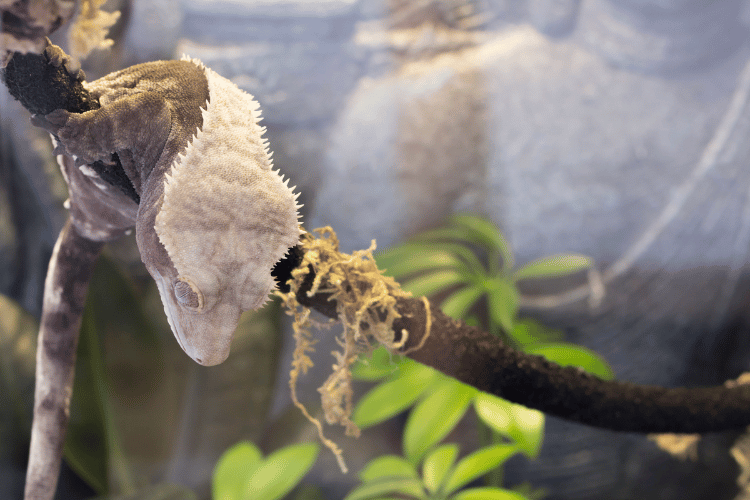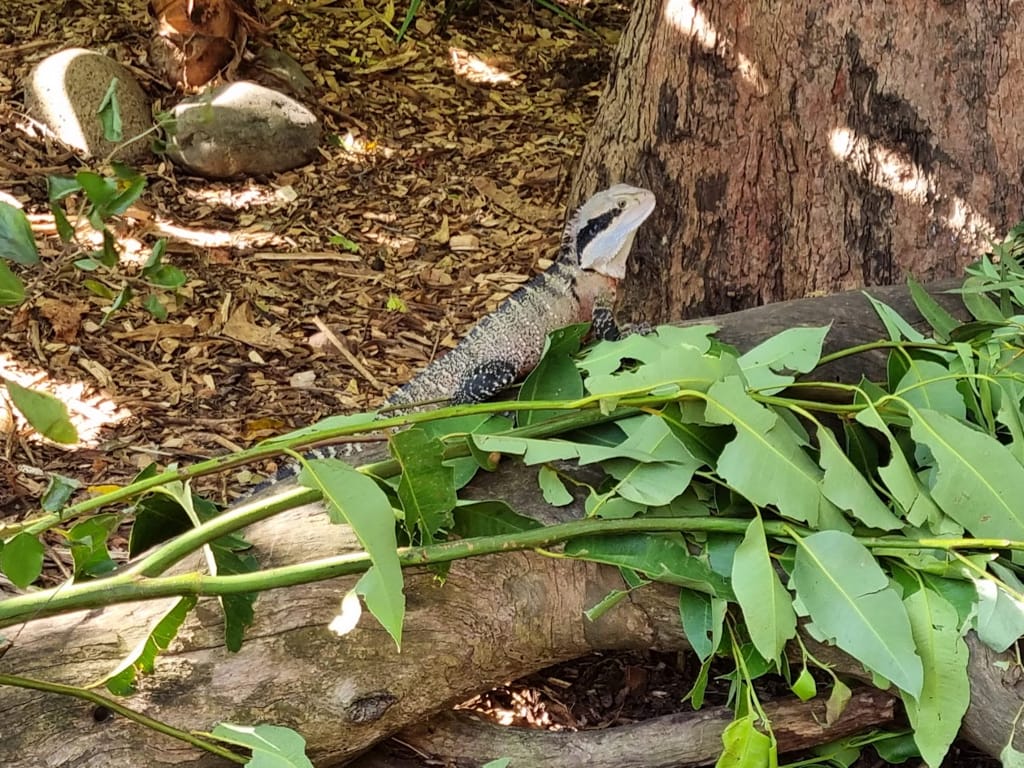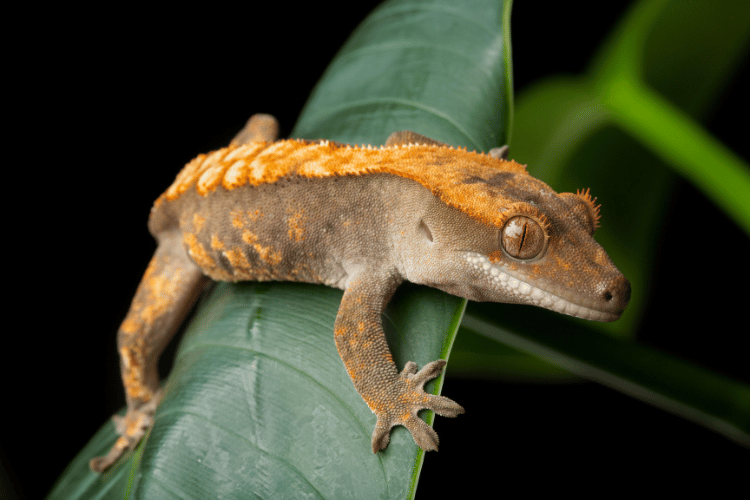If you’re ready to delve into the world of owning reptiles, most seasoned pet parents will recommend you start small. You may think of getting a crested gecko or a bearded dragon, but which one should your ultimate choice be?
To be fair, it can be a tad hard to spot the differences between the two species for the untrained eye, and we’re not talking about physical characteristics. That’s why this guide is here to educate you on what to expect from a crested gecko vs. bearded dragon.
Let’s dive in!

Crested Gecko vs. Bearded Dragon: Size, Weight, Behavior, Diet, and More!
In the following comparison, we see how the crested gecko and bearded dragon are doing in terms of appearance, temperament, tank requirements, and more.
By understanding these differences, no matter how slight, you can finally determine which pet is right for you to take home!
Size, Weight, and Appearance
Both types of lizards are on the medium side in the grand scheme of things, but the crested gecko tends to be smaller. Where the average length of the bearded dragon is around 24 inches, its cousin may only grow to a little more than nine inches!
Naturally, the bearded dragon also weighs more, say 0.7–1.2 pounds (350–550 grams). Furthermore, it has the tendency to put on even more weight because it’s easy to overfeed, reaching up to way more than one pound in almost no time!
On the other hand, the tinier crested gecko usually has a maximum adult weight of 1.7 ounces (50 grams). Unlike the dragon, it’s less likely to suffer from obesity because its body does a better job of regulating its food consumption, even if you give it too much food.
As for their appearance differences, you can easily tell those from the names!
The bearded dragon—also known as beardie!—has a remarkable beard-like, spiky stretch of skin around its throat. When sensing danger or wanting to establish dominance, this lizard puffs up its beard in defiance.
Beardies are available in tan or light brown varieties.
Contrarily, the crested gecko comes with a crest of skin on its head and back. You may find it in a wide selection of colors, such as gray, orange, red, and brown.

Optimum Environment and Tank Requirements
To give your gecko or bearded dragon proper care, you must first understand what it requires in its tank. Thankfully, these two reptiles aren’t very demanding!
The crested gecko will appreciate a medium-sized vertical terrarium with plenty of plants and rocks for climbing and hiding. Because of its smaller size, it can live in tank dimensions ranging from 12” x 12” x 18” to 18” x 18” x 24” based on whether it’s a baby or adult.
As for its temperature needs, the crested gecko likes a range of 72–78°F (22–25°C) when it’s daytime. Its basking spot can be slightly warmer, say at 85°F (29°C).
During the evening hours, experienced pet owners recommend a temperature of 65–72°F (18–22°C).
Alternatively, beardies will require larger 20- or 40-gallon tanks that have a horizontal orientation. To match their natural habitat, ensure their enclosure has a substrate for burrowing, basking areas, and plenty of hiding spots for some alone time!
Bearded dragons prefer a more expansive temperature range in their glass tanks. You’d best keep the basking locations at 95–110°F (35–43°C) while also providing a cooler area with a temperature of 75–85°F (24–29°C).
Lastly, you’ll want to think about the ideal humidity levels to maintain inside the tank. Cresties thrive in 40–50% humidity, but you should raise those numbers to 70% once a day because these creatures like a moist environment.
As for bearded dragons, you may keep the humidity in their tank at 30–50% all the time.
Light Needs
Did you know that crested geckos and bearded dragons have specific light exposure requirements to stay healthy?
For example, beardies must be exposed to 14–16 hours of daytime light during the summer. This means placing their tank in a room that bright sunlight gets access to for the entire day.
In addition to that, these reptiles require eight hours of light at night, which is easily achievable with a good quality UVB bulb inside the tank.
As for winter, bearded dragons will only need 12 hours of daylight exposure and 12 hours of night light.
When it comes to crested geckos, you must provide them with 14 hours of sunlight in the summer months and 10 in the winter.
They don’t depend on UVB lighting as much as bearded dragons do, but you should still install a lamp if your pet doesn’t get sufficient light during the day.
Diet
Next up, let’s talk about the dietary needs of the crested gecko vs. bearded dragon.
First, you should know that both must have a water bowl in their enclosures. Always make sure there’s fresh water for your little creatures, changing it every now and then to maintain its quality.
Second, when it comes to food, both species are omnivorous, but they like the major bulk of their daily intake to be insects.
Think along the lines of crickets, roaches, and several types of worms, such as waxworms and silkworms. However, in the case of crested geckos, choose small insects so that they’re easier to munch on!
Bearded dragons and crested geckos can have a wide range of fruits or vegetables that you can mash or chop to fit their tiny mouths. A few suggestions include:

- Kale
- Dandelion
- Carrots
- Sweet potato
- Mango
- Peaches
- Melon
Finally, you can put your mind at ease by purchasing prepackaged food specially made for either species.
Temperament, Behavior, and Activity
As a new pet lizard parent, the ultimate choice of crested gecko vs. bearded dragon will have a lot to do with each reptile’s temperament.
A lot of experienced pet owners like crested geckos for being docile and easy to pick up. Still, they tend to be shy and sometimes nervous around new people, so you’ll have to let them get used to you over the course of days until they relax to your touch.
These geckos are nocturnal; you should expect yours to sleep the entire day. Therefore, if you want to see it go about its tank, prepare yourself to wait for it until it wakes up at night unless you’re a night owl yourself!
The personality of bearded dragons is quite pleasant, too, and they don’t mind occasional handling either. However, they’re quick to become aggressive if they feel threatened.
These buddies, on the contrary, are diurnal. That’s great news for people who fall asleep early!
Lifespan
Quite surprisingly, you’ll find that the smaller crested geckos tend to outlive bearded dragons. See, the average lifespan of cresties ranges from 15 to 20 years, while beardies can stay alive for up to 10 to 15 years.
Of course, if you want to increase your lizard’s life expectancy, following all the right care guidelines is the first step in that direction.
By giving your reptile nutritious meals, maintaining the ideal tank environment parameters, and visiting the vet periodically, you can help it lead a long, joyful life!
Health Issues
Despite being generally healthy species, both crested geckos and bearded dragons may suffer from a few troublesome conditions throughout their lifetimes.
For instance, cresties are prone to developing the following diseases:
- Respiratory infections: Identifiable by drooling and wheezing
- Mouth rot or stomatitis: Easy to detect by noticing irritation around the mouth or excessive production of mucus
- Skin infections: Usually occur because of a less-than-ideal enclosure environment, signs include trouble with shedding and rashes
- Parasites: Annoying creatures like mites and ticks that can be lethal if you don’t treat them as soon as you discover them
- Metabolic bone disease: Happens when the reptile’s diet isn’t rich in calcium or vitamin D3 but has too much phosphorus
Luckily, beardies have stronger systems than geckos, so they’re much hardier. But that doesn’t mean they don’t have their weaknesses.
The health concerns of bearded dragons include:
- Impaction: When the digestive system suffers from blockages as a result of improper eating habits
- Metabolic bone disease: Can be prevented with a balanced diet that contains all the minerals and vitamins that a bearded dragon needs
- CANV: A fungal infection that’s easy to identify by yellow plaques on the mouth, sides, back, and legs
- Infectious stomatitis: Also known as mouth rot, which is a bacterial infection of the jawbone and gums
- Pneumonia and other respiratory infections: Usually a result of poor tank conditions, stress, or an improper feeding schedule
Initial Price and Other Costs
The last point of comparison that you should think about before buying either lizard is whether or not you’ll financially afford to take it home. Remember that it isn’t only about the purchase price, but also all the rest of the costs associated with your pet’s life in your house.
Initial Price
Of course, there isn’t a fixed price for either crested geckos or bearded dragons because they’re available in a wide range of morphs and ages. Yet, in most cases, beardies are more expensive than cresties.
To be more specific, the price of beardies tends to be anywhere from $50 to $500, while the priciest crestie will only have you pay around $150. Still, you may stumble upon designer breeds, which might drive the price to the thousands!
Care Costs
Here’s a quick breakdown of the amount of money you can expect to pay to make your crested gecko comfortable at your place:
- Glass enclosure: $100 to $250
- Enclosure equipment and accessories (substrate, lighting, food and water bowls, branches, etc.): $130 to $150
- Thermometer/hygrometer: Around $30
- Food: Around $150 to $250 per year
- Routine vet visits: $50 to $80 per year
Likewise, these are the costs associated with owning and taking care of a bearded dragon:
- Glass enclosure: $300 or more
- Enclosure equipment and accessories (substrate, lighting, food and water bowls, branches, etc.): $150 to $200
- Thermometer/hygrometer: Around $30
- Food: Around $400 to $1,200 per year
- Routine vet visits: $60 to $100 per year
As you can see, it requires a bigger budget to keep a bearded dragon, while owning a crestie is more suitable for people wishing to save some money.

Another noteworthy observation is that some of the previous points are one-time purchases (like the enclosure). On the other hand, items like the substrate, light bulbs, and accessories may need frequent changing.
Therefore, you should take the total sum of these costs as an approximate estimation.
FAQs
Is the crested gecko or the bearded dragon better for beginners?
While both species are wonderful choices for first-time reptile keepers, most newbie pet parents might lean toward the crested gecko. That’s because it’s easier to handle, costs less, and doesn’t require much space.
Plus, crested geckos are much more low-maintenance than their bearded cousins. Let’s not forget that families with children prefer geckos because they’re less likely to bite or display aggressive behavior.
Can you keep both the crested gecko and bearded dragon in the same tank?
No. As we’ve mentioned earlier in our comparison, bearded dragons and crested geckos have different requirements in their terrariums. Their temperature needs, preferred moisture levels, ideal tank size, and other parameters aren’t the same.
As a result, you’ll accidentally hurt one in favor of the other. If you try to set a middle ground, you may harm both reptiles.
Most importantly, bearded dragons are a lot larger than crested geckos, not to mention that they’re territorial. So, keeping them together may expose your tiny gecko to attacks by the dragon.
To Wrap It Up
As a novice reptile owner, comparing the crested gecko vs. bearded dragon is the best way to tell which one is suitable for you. Of course, there’s no definitive answer to which is better, as it’s all based on your preferences, lifestyle, and budget.
To sum it up, crested geckos may be the perfect fit for beginners because of their docile nature. They also work well for busy people who need a low-maintenance reptile that’s easy to care for.
Bearded dragons may be a good choice for first-timers, too, if you’re willing to keep up with their higher feeding demands and sometimes moody characters. They’re also more expensive to buy and keep.
- Can Leopard Geckos Eat Silkworms? - March 11, 2024
- Do Leopard Geckos Climb? - March 4, 2024
- Do Leopard Geckos Bask? The Answer Will Surprise You - February 21, 2024
